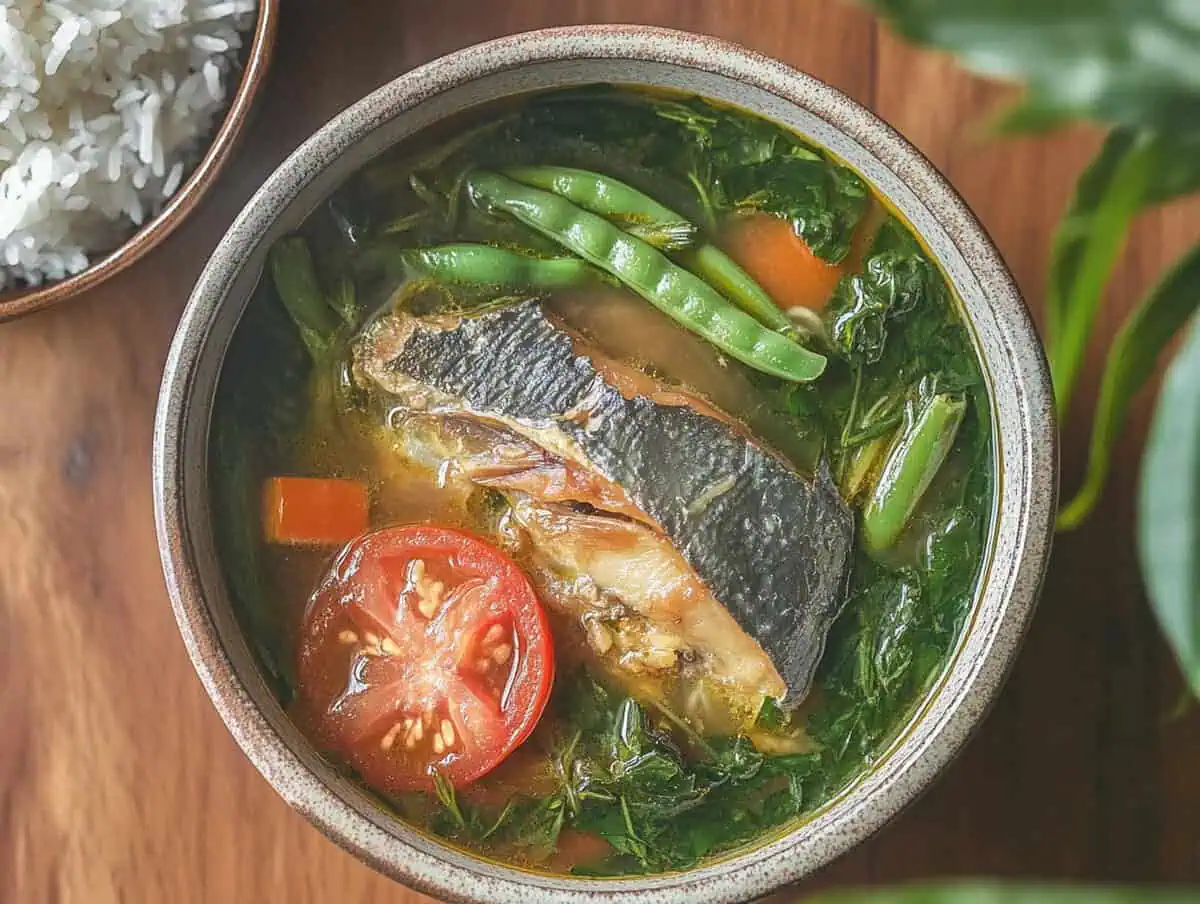I am going to teach how to cook Sinigang sa Miso. This treasured Filipino soup holds a special place in my heart and has become a family favorite. I've perfected this recipe through years of Sunday family dinners, combining the signature sourness of traditional sinigang with the rich umami flavor of miso paste.
The result? A comforting bowl of tender fish and fresh vegetables swimming in a tangy, savory broth that warms you from the inside out. It's my go-to recipe when the weather turns cool or when anyone needs a taste of Filipino comfort food.
What is Sinigang Sa Miso?
Sinigang sa Miso is a Filipino sour soup enhanced with miso paste. Traditional sinigang features a clear sour broth made with tamarind or other souring agents, while this version incorporates miso (fermented soybean paste) for added depth and richness.
The addition of miso to sinigang likely originated from Japanese immigrants who arrived in the Philippines in the early 20th century, creating this wonderful fusion dish. Miso not only adds savory umami flavor but also thickens the broth slightly, giving it a creamier texture. It's packed with protein, fiber, and vitamins, making an already nutritious dish even more beneficial.
Jump to:
Why You'll Love This Recipe
This Sinigang sa Miso combines the beloved sour flavors of traditional Filipino sinigang with the rich umami taste of Japanese miso paste. The fermented soybean paste transforms the broth into a creamy, savory delight while maintaining the signature tanginess that makes sinigang so comforting.
This dish is perfect for rainy days or cold evenings when you need something warming and nourishing. The combination of tender fish, fresh vegetables, and flavorful broth creates a complete meal that's both satisfying and healthy. Rich in protein, vitamins, and minerals, it's as nutritious as it is delicious.
Ingredients
I've carefully selected each ingredient in this Sinigang sa Miso to create the perfect balance of flavors and textures. The bangus provides a delicate sweetness that pairs beautifully with the sour tamarind and savory miso paste.
Tomatoes and onions create the aromatic base, while the varied vegetables add nutrition, color, and different textures. The kangkong leaves wilt just enough to absorb all the wonderful flavors while still maintaining their fresh bite.
This combination has proven time and again to deliver the most satisfying bowl of comfort.

- 2 lbs bangus (milkfish), cleaned and sliced
- 2 teaspoons salt
- 3 tablespoons cooking oil
- 1 yellow onion, cut into wedges
- 2 tomatoes, cut into wedges
- 2 tablespoons miso paste
- 2 quarts water
- 25g tamarind soup base mix (such as Maggi Magic Sinigang sa Sampaloc)
- 4 pieces long green pepper
- 12 string beans, cut into 2-inch pieces
- 10 okra
- 1 bunch fresh kangkong leaves (water spinach)
- Fish sauce and ground black pepper to taste
Equipment
- Large pot or Dutch oven
- Frying pan (if pre-frying the fish)
- Sharp knife
- Cutting board
- Measuring spoons
- Stirring spoon or ladle
- Serving bowl

How To Make
- Prepare the fish: Rub salt all over the bangus slices. Let it sit for 10 minutes. This helps remove excess moisture and enhances the flavor.
- Fry the fish: Heat oil in a pot over medium heat. Fry each side of the fish for 1-2 minutes until lightly browned. Remove the fish from the pot and set aside.
- Sauté aromatics: Using the remaining oil in the pot, add onion, half of the tomatoes, and miso paste. Sauté for 2 minutes to blend flavors and soften the vegetables.
- Create the broth: Return the fried fish to the pot and pour in water. Bring to a boil.
- Simmer: Cover and cook using low to medium heat for 10 minutes.
- Add souring agent: Stir in the tamarind soup base mix. Cook for 2 minutes.
- Cook vegetables: Add green peppers, string beans, and okra. Stir, cover, and cook for 5-7 minutes.
- Season: Add fish sauce and ground black pepper to taste. Stir well to combine.
- Finish with greens: Add the kangkong leaves to the pot. Cover and turn off the heat. Let it steep for 5 minutes to wilt the greens perfectly.
- Serve: Transfer to a serving bowl and enjoy hot with steamed rice.

Tips from Lola's Kitchen
- Pre-fry the fish: This crucial step triggers the Maillard reaction, which develops deeper flavors and aromas that enrich your broth significantly. Don't skip this step!
- Balance the sourness: Sinigang should be distinctly sour - don't be too timid with your souring agent. You can always adjust with a bit of fish sauce for balance.
- Layer your vegetables: Add vegetables in stages based on cooking time. Hard vegetables first, leafy greens last.
- Simmer gently: Once boiling, reduce to a gentle simmer to keep the fish intact and prevent the broth from becoming cloudy.
- Taste as you go: The perfect sinigang balances sour, savory, and umami flavors. Adjust seasonings gradually until you reach the perfect balance.
Substitutions
- Fish options: While bangus (milkfish) is traditional, you can use tilapia, salmon, king fish, or tuna with excellent results.
- Souring agent: If you don't have tamarind soup mix, use 3-4 tablespoons of tamarind paste mixed with water, or 3-4 pieces of real tamarind fruit simmered and strained.
- Miso varieties: White or yellow miso works best for this dish. Red or brown miso has a stronger flavor that might overpower the soup.
- Vegetable alternatives: Feel free to use mustard leaves, daikon radish, or eggplant in place of or in addition to the vegetables listed.
- Kangkong substitute: If water spinach isn't available, regular spinach or bok choy make good alternatives.
Troubleshooting
- Fish falling apart: Be gentle when stirring and don't overcook the fish. If using a delicate fish, you can add it later in the cooking process.
- Soup not sour enough: Add more tamarind mix or a squeeze of calamansi/lime juice to increase sourness.
- Too salty: Add a bit more water or a potato chunk (remove before serving) to absorb excess salt.
- Broth is cloudy: Next time, maintain a gentler simmer and be careful not to break up the fish.
- Miso clumps: Dissolve miso in a small amount of hot broth before adding to the pot, or strain your soup if needed.
Storage & Reheating
- Refrigeration: Store in an airtight container for 3-5 days at 40°F (4°C) or below.
- Reheating: Gently reheat on the stovetop until it reaches 165°F (74°C) or maintains a gentle boil for 2 minutes. Avoid microwaving as it can make the fish texture tough.
- What to expect: The broth may separate slightly due to the acidity and miso, but this is normal. Simply stir when reheating to recombine.
- Freezing: Not recommended for this dish as the texture of the fish and vegetables will deteriorate.

FAQ
Why do we fry the fish before adding it to the soup?
Frying the fish creates rich, complex flavors through the Maillard reaction, which significantly enhances the broth. It also helps the fish hold together better during simmering.
Can I make this dish less sour?
Yes, simply use less of the tamarind mix or souring agent to reduce the sourness according to your preference.
What's the best way to serve Sinigang sa Miso?
Serve hot with steamed white rice and a side condiment of fish sauce with crushed Thai chili peppers for those who enjoy a bit of heat.
Can I add other seafood to this dish?
Absolutely! Shrimp, clams, or mussels make wonderful additions. Add them in the final few minutes of cooking to prevent overcooking.
Is there a vegetarian version of this dish?
Yes, you can substitute the fish with firm tofu and use vegetable broth instead of fish sauce for seasoning.
How can I tell when the dish is done?
The soup is ready when the vegetables are tender but still vibrant in color, and the fish is fully cooked but still moist. The broth should have a balanced sour and savory flavor.
Related
Looking for other recipes like this? Try these:

Sinigang Sa Miso
Ingredients
- 2 lbs bangus milkfish, cleaned and sliced
- 2 teaspoons salt
- 3 tablespoons cooking oil
- 1 yellow onion cut into wedges
- 2 tomatoes cut into wedges
- 2 tablespoons miso paste
- 2 quarts water
- 25 g tamarind soup base mix such as Maggi Magic Sinigang sa Sampaloc
- 4 pieces long green pepper
- 12 string beans cut into 2-inch pieces
- 10 okra
- 1 bunch fresh kangkong leaves water spinach
- Fish sauce and ground black pepper to taste
Instructions
- Prepare the fish: Rub salt all over the bangus slices. Let it sit for 10 minutes. This helps remove excess moisture and enhances the flavor.
- Fry the fish: Heat oil in a pot over medium heat. Fry each side of the fish for 1-2 minutes until lightly browned. Remove the fish from the pot and set aside.
- Sauté aromatics: Using the remaining oil in the pot, add onion, half of the tomatoes, and miso paste. Sauté for 2 minutes to blend flavors and soften the vegetables.
- Create the broth: Return the fried fish to the pot and pour in water. Bring to a boil.
- Simmer: Cover and cook using low to medium heat for 10 minutes.
- Add souring agent: Stir in the tamarind soup base mix. Cook for 2 minutes.
- Cook vegetables: Add green peppers, string beans, and okra. Stir, cover, and cook for 5-7 minutes.
- Season: Add fish sauce and ground black pepper to taste. Stir well to combine.
- Finish with greens: Add the kangkong leaves to the pot. Cover and turn off the heat. Let it steep for 5 minutes to wilt the greens perfectly.
- Serve: Transfer to a serving bowl and enjoy hot with steamed rice!
Tips from Lola's Kitchen
- Pre-fry the fish: This crucial step triggers the Maillard reaction, which develops deeper flavors and aromas that enrich your broth significantly. Don't skip this step!
- Balance the sourness: Sinigang should be distinctly sour - don't be too timid with your souring agent. You can always adjust with a bit of fish sauce for balance.
- Layer your vegetables: Add vegetables in stages based on cooking time. Hard vegetables first, leafy greens last.
- Simmer gently: Once boiling, reduce to a gentle simmer to keep the fish intact and prevent the broth from becoming cloudy.
- Taste as you go: The perfect sinigang balances sour, savory, and umami flavors. Adjust seasonings gradually until you reach the perfect balance.
The Story Behind Sinigang sa Miso
The story of Sinigang sa Miso begins with two culinary traditions meeting in perfect harmony. Traditional Filipino sinigang has been a cornerstone of Filipino cuisine for centuries, with its signature sour broth typically made from tamarind, offering comfort in a bowl during rainy days and family gatherings. This beloved soup is so ingrained in Filipino culture that many consider it the unofficial national dish, representing the Filipino love for sour flavors.
The introduction of miso to this classic recipe created something truly special. Miso paste, an ancient Japanese seasoning made from fermented soybeans, salt, and koji (a type of fungus), has been used in Japanese cooking for over a thousand years. When these two culinary traditions merged, Sinigang sa Miso was born – a perfect example of how Filipino cuisine has always welcomed foreign influences while making them distinctly its own.
The fusion likely began during the early 20th century, when Japanese immigrants arrived in the Philippines bringing their culinary traditions with them. The Philippines has a long history of absorbing culinary influences – from Chinese, Spanish, American, and in this case, Japanese cuisine. Instead of simply adopting foreign dishes, Filipinos have always had a remarkable talent for incorporating new ingredients into traditional recipes.
In coastal regions where seafood was abundant and Japanese influence stronger, cooks began experimenting with adding miso to their sinigang, discovering that the fermented paste added incredible depth and umami flavor to the already delicious sour soup. The pairing made perfect sense – both Japanese and Filipino cuisines value the balance of flavors and the freshness of ingredients, particularly seafood.
What began as culinary experimentation has now become a beloved variation found in Filipino homes and restaurants. The miso not only enhances the flavor profile of traditional sinigang but also provides nutritional benefits. Fermented foods like miso are rich in probiotics, enzymes, and antioxidants that support gut health and immunity.
While purists might stick to traditional tamarind-only sinigang, many Filipino families now embrace Sinigang sa Miso as part of their regular recipe rotation. The dish represents the adaptability and creativity of Filipino cuisine, always evolving while maintaining its distinct identity and connection to family traditions.
Like many Filipino dishes, Sinigang sa Miso has developed regional variations across the country. In coastal areas, it's often made with the freshest catch of the day – sometimes using fish heads for extra flavor. In urban centers like Manila, you'll find more experimental versions using salmon or even premium fish like maya-maya (red snapper). Northern regions of the Philippines might include local vegetables like mustasa (mustard leaves), while southern variations could incorporate more chili for a spicier kick. Some families even combine multiple souring agents – using both miso and tamarind for a more complex flavor profile.
What remains consistent is the soul of the dish – a hearty, sour soup that brings people together around the table. Whether enjoyed during monsoon season with rain pattering on the roof or served for Sunday family lunch, Sinigang sa Miso represents the heart of Filipino cooking: transforming simple ingredients into something greater than the sum of its parts.
My own journey with Sinigang sa Miso began in my grandmother's kitchen, where I watched her carefully balance the tanginess of tamarind with the rich umami of miso paste. She taught me that the pre-frying of fish wasn't just for texture but created a deeper flavor foundation for the entire dish. These cooking secrets have been passed down through generations, and now I'm sharing them with you.
This recipe honors traditional techniques while making the dish accessible for modern home cooks. Whether you're Filipino seeking a taste of home or an adventurous eater exploring new cuisines, this Sinigang sa Miso recipe invites you to experience a beautiful cultural fusion that has stood the test of time and continues to bring joy to countless dinner tables.










Comments
No Comments